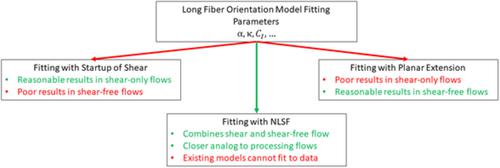当前位置:
X-MOL 学术
›
Polym. Compos.
›
论文详情
Our official English website, www.x-mol.net, welcomes your
feedback! (Note: you will need to create a separate account there.)
Comparing fiber orientation evolution between startup of shear and nonlubricated squeeze flow
Polymer Composites ( IF 4.8 ) Pub Date : 2020-09-23 , DOI: 10.1002/pc.25810 Gregory M. Lambert 1, 2 , Peter Wapperom 3 , Donald Baird 1, 2
Polymer Composites ( IF 4.8 ) Pub Date : 2020-09-23 , DOI: 10.1002/pc.25810 Gregory M. Lambert 1, 2 , Peter Wapperom 3 , Donald Baird 1, 2
Affiliation

|
Light weighting has become an integral part of vehicle design. This strategy makes use of fiber‐reinforced thermoplastics, which can be injection molded into complex shapes. Composite design work requires knowledge of the orientation state throughout a part to predict properties like stiffness and strength. Although evolution models for the orientation state have been developed, each requires empirical parameters, and no standard method for obtaining these exists. This work continues efforts to find such a test, particularly for long (average length > 1 mm) glass fiber composites. Here, a polypropylene loaded with 30, 40, and, 50 wt% long glass fiber is subjected to startup of shear and nonlubricated squeeze flow (NLSF). The orientation evolution was reported for both flows and an attempt was made at fitting several orientation models to the data. The measured orientation evolution from startup of shear was slower than expected, and this slower evolution appears to result from the combination of the initial orientation state and fiber concentration. On the other hand, the measured orientation profile from NLSF was found to be essentially independent of fiber concentration. However, the NLSF orientation profile could not be replicated with a single set of parameters. Rather, shear‐like parameters made reasonable predictions in shear‐dominated regions, and extension‐like parameters made reasonable predictions in extension‐dominated areas, in concordance with results from short glass fiber composites.
中文翻译:

比较剪切启动和非润滑挤压流之间的纤维取向演变
轻量化已成为车辆设计不可或缺的一部分。该策略利用了纤维增强的热塑性塑料,可以将其注塑成复杂的形状。复合设计工作需要了解整个零件的定向状态,以预测诸如刚度和强度之类的属性。尽管已经开发出用于取向状态的演化模型,但是每个模型都需要经验参数,并且不存在获得这些参数的标准方法。这项工作将继续努力找到这样的测试,特别是对于长(平均长度>1毫米)玻璃纤维复合材料。在此,负载了30%,40%和50%重量百分比的玻璃纤维的聚丙烯开始进行剪切和非润滑挤压流(NLSF)。报告了两种流动的方向演变,并尝试将多个方向模型拟合到数据中。从剪切开始时测得的取向演变比预期的要慢,并且这种较慢的演变似乎是由于初始取向状态和纤维浓度的组合而导致的。另一方面,发现从NLSF测得的取向分布基本上与纤维浓度无关。但是,NLSF方向配置文件无法使用单个参数集进行复制。相反,类似剪切的参数在剪切为主的区域做出了合理的预测,
更新日期:2020-09-23
中文翻译:

比较剪切启动和非润滑挤压流之间的纤维取向演变
轻量化已成为车辆设计不可或缺的一部分。该策略利用了纤维增强的热塑性塑料,可以将其注塑成复杂的形状。复合设计工作需要了解整个零件的定向状态,以预测诸如刚度和强度之类的属性。尽管已经开发出用于取向状态的演化模型,但是每个模型都需要经验参数,并且不存在获得这些参数的标准方法。这项工作将继续努力找到这样的测试,特别是对于长(平均长度>1毫米)玻璃纤维复合材料。在此,负载了30%,40%和50%重量百分比的玻璃纤维的聚丙烯开始进行剪切和非润滑挤压流(NLSF)。报告了两种流动的方向演变,并尝试将多个方向模型拟合到数据中。从剪切开始时测得的取向演变比预期的要慢,并且这种较慢的演变似乎是由于初始取向状态和纤维浓度的组合而导致的。另一方面,发现从NLSF测得的取向分布基本上与纤维浓度无关。但是,NLSF方向配置文件无法使用单个参数集进行复制。相反,类似剪切的参数在剪切为主的区域做出了合理的预测,









































 京公网安备 11010802027423号
京公网安备 11010802027423号